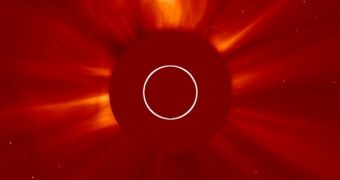Astronomers keeping an eye on the Sun say that the 2011 summer solstice, which took place yesterday, June 21, was accompanied by a storm of activity on the surface of the Sun. The two events are unrelated, but the coincidence was more than welcomed among solar physicists.
A solar flare and a coronal mass ejection marked the year's longest day, experts say. The large amounts of solar material that were produced by the Sun were directed mostly straight at Earth, but the good news is that the solar storms were only moderate in intensity.
The event occurred in the early hours of June 21, when the beginning of the storm was marked by the appearance of a moderate C7-class solar flare on the surface of the star. Several observatories, belonging to NASA and the European Space Agency (ESA) monitored the situation.
The orbital Solar and Heliospheric Observatory (SOHO) spacecraft was the main satellite to capture data on the two events. Early detection of such explosions in very important, scientists say, because a stream of highly-charged particles is heading for Earth.
It's very unlikely that they will cause any sort of damage as they hit Earth. The planetary magnetosphere will most likely divert these particles away from Earth, but skywatchers could expect to see more luminous auroras over the next couple of days.
Shortly after the moderate C7-class solar flare was developed, a powerful CME followed. It was during the ejection event that solar matter was expelled from the star, and set on a course towards our planet.
“Magnetic fields above sunspot complex 1236 erupted during the early hours of June 21st, hurling a coronal mass ejection almost directly toward Earth,” a Spaceweather.com alert reads.
“The incoming CME does not appear to be particularly potent; nevertheless, the cloud could trigger polar geomagnetic storms when it reaches Earth on or about June 23rd,” the document goes on to say.
These levels of solar activity are due to the fact that the Sun is approaching the maximum of its 11-year cycle. This is scheduled to happen in 2012 or 2013, astronomers say. This means that the next couple of years will see the star producing increasingly large numbers of solar flares and CME, Space reports.
SOHO and other observatories, including STEREO, Hinode and SDO, will continue to monitor the Sun from multiple vantage points, in a bid to detect the earliest signs of solar storms.

 14 DAY TRIAL //
14 DAY TRIAL //